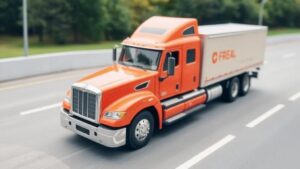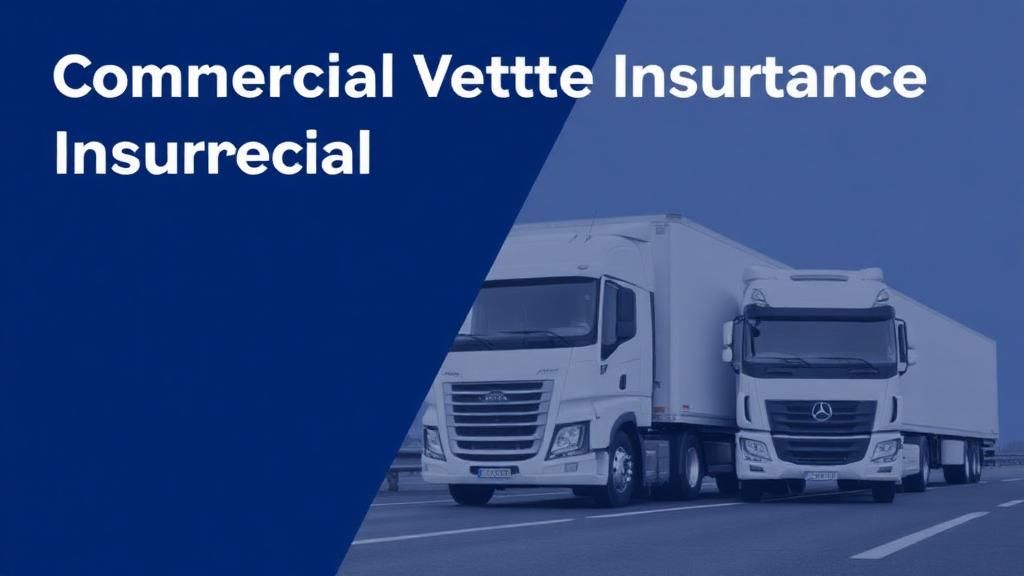Managing a fleet of vehicles—whether it’s a handful of delivery vans or hundreds of trucks—comes with big responsibilities. One accident or theft can disrupt operations, cause major financial loss, and even expose your company to lawsuits. That’s why commercial vehicle fleet insurance is a critical investment for any business that relies on multiple vehicles.
This comprehensive guide explains everything you need to know in 2025: what fleet insurance covers, how it works, key cost factors, and smart strategies to reduce premiums without sacrificing protection.

What Is Commercial Vehicle Fleet Insurance?
Commercial vehicle fleet insurance is a single policy that covers multiple business-owned vehicles under one umbrella. Instead of insuring each car, van, or truck separately, you can insure your entire fleet together.
Key Features:
- One policy, one renewal date, and one premium for the entire fleet.
- Flexible coverage for a mix of vehicles—cars, vans, trucks, trailers, and specialty equipment.
- Coverage for a range of drivers, including employees and contractors.
This streamlined approach saves time, simplifies paperwork, and often reduces total costs compared to insuring vehicles individually.
Why Your Business Needs Fleet Insurance
1. Legal Compliance
Most countries and U.S. states require a minimum level of liability insurance for commercial vehicles. A fleet policy ensures every vehicle meets those requirements.
2. Financial Protection
Accidents, natural disasters, or theft can lead to expensive repairs, medical bills, and legal claims. Fleet insurance shields your company’s balance sheet.
3. Operational Efficiency
A single policy means fewer administrative headaches. Renewals, claims, and updates are handled through one insurer, freeing your team to focus on operations.
4. Driver Flexibility
Employees can operate different vehicles within the fleet without needing to be individually named on separate policies.
Types of Coverage in a Fleet Insurance Policy
A robust commercial vehicle fleet policy typically includes several layers of protection:
• Liability Insurance
Covers bodily injury and property damage to third parties if your driver is at fault.
• Physical Damage
Pays for repairs or replacement if your fleet vehicles are damaged by collisions, vandalism, or natural disasters.
• Comprehensive Coverage
Protects against non-collision losses such as theft, fire, or severe weather.
• Uninsured/Underinsured Motorist
Covers injuries or damage if your vehicle is hit by an uninsured or underinsured driver.
• Medical Payments/Personal Injury Protection
Covers medical expenses for drivers and passengers, regardless of fault.
• Cargo or Goods-in-Transit
Essential for delivery businesses, covering the goods you transport.
• Rental Reimbursement & Downtime
Pays for rental vehicles or lost income when a fleet vehicle is out of service.
Tip: Coverage needs differ by industry. A construction company might need specialized equipment coverage, while a courier service may prioritize cargo protection.

Who Needs Commercial Vehicle Fleet Insurance?
Fleet insurance is ideal for any business operating two or more vehicles, including:
- Delivery and logistics companies
- Taxi and ride-share fleets
- Construction and contracting firms
- Landscaping or service businesses
- Municipalities and government agencies
- Corporate sales teams or executive transport services
Whether you manage five vehicles or 500, a fleet policy is more cost-effective and easier to manage than individual commercial auto policies.
Cost of Fleet Insurance in 2025
The price of commercial vehicle fleet insurance varies widely based on several factors.
| Cost Factor | Typical Impact on Premium |
|---|---|
| Number of Vehicles | More vehicles mean higher premiums, but bulk rates lower per-vehicle cost. |
| Vehicle Types & Usage | Heavy trucks or hazardous-material carriers cost more than passenger cars. |
| Driver Records | Fleets with clean driving histories enjoy lower rates. |
| Location & Territory | Urban areas with higher accident rates increase premiums. |
| Annual Mileage | More miles driven = higher risk. |
| Coverage Limits & Deductibles | Higher limits cost more; higher deductibles lower premiums. |
| Safety & Telematics Programs | Insurers offer discounts for GPS tracking, dashcams, and safety training. |
Average U.S. Premiums (2025):
- Small fleet (5–10 light-duty vehicles): $4,000–$9,000 per year.
- Medium fleet (20–50 mixed vehicles): $20,000–$75,000 per year.
- Large trucking fleet: $100,000+ annually depending on risk.
Remember, insurers usually provide fleet discounts that reduce the per-vehicle cost as your fleet grows.
Steps to Get a Commercial Fleet Insurance Quote
- Gather Fleet Information
List every vehicle’s make, model, VIN, and usage details. - Compile Driver Data
Collect license numbers and driving histories for all employees who operate fleet vehicles. - Assess Your Coverage Needs
Consider liability limits, comprehensive coverage, cargo protection, and any industry-specific endorsements. - Compare Multiple Insurers
Get at least three quotes. Look beyond price—check financial strength and claims reputation. - Ask About Discounts
Many insurers offer reduced rates for installing telematics devices, implementing driver training, or maintaining a strong safety record.
Top Insurers Offering Fleet Insurance in 2025
While availability varies by region, the following providers are well-known for commercial vehicle fleet coverage:
- Progressive Commercial – Strong for small and mid-size fleets.
- Nationwide – Flexible policies and telematics discounts.
- Travelers – Excellent for large, mixed fleets and logistics companies.
- State Farm – Competitive pricing for regional service fleets.
- Liberty Mutual – Specialized solutions for heavy trucking and cargo.
Always verify local providers too—regional insurers sometimes offer better rates tailored to your area.
Risk Management & Safety Programs
Reducing accidents not only protects lives and property but also lowers your premiums. Consider:
- Driver Training & Certification
Regular safety courses and defensive driving refreshers. - Telematics & GPS Tracking
Monitor speed, braking, and route efficiency; many insurers reward fleets with discounts. - Vehicle Maintenance Schedules
Proactive maintenance reduces breakdowns and accident risk. - Clear Fleet Policies
Written rules about mobile phone use, seatbelt requirements, and reporting procedures.
A documented safety culture can save thousands of dollars annually.
Tax Advantages
Commercial vehicle fleet insurance premiums are generally 100% tax-deductible as a business expense. Keep detailed records for accounting and annual tax filings.
International Perspective
Fleet insurance requirements and costs differ across countries:
- U.K.: Fleet policies can cover as few as two vehicles. Many insurers provide “any driver” coverage for flexible staffing.
- Australia: Discounts are offered for fleets with advanced telematics and low claims histories.
- India: Growing demand for logistics fleet insurance has led to competitive group rates for transport companies.
Global businesses should work with brokers familiar with local regulations.
Tips to Reduce Fleet Insurance Costs
- Bundle Policies
Combine fleet coverage with general liability or property insurance for multi-policy discounts. - Increase Your Deductible
Higher deductibles lower premiums—just ensure your cash reserves can handle the out-of-pocket risk. - Regular Driver Screening
Hire experienced drivers with clean records and conduct periodic checks. - Reward Safe Driving
Implement incentive programs for accident-free miles. - Annual Policy Review
Update your policy as vehicles are added or retired to avoid overpaying.
Common Mistakes to Avoid
- Failing to Update Vehicle Lists – Unlisted vehicles may not be covered during a claim.
- Underinsuring Liability – Cutting coverage to save money can expose your business to lawsuits.
- Ignoring Small Claims – Frequent minor claims can raise premiums over time; focus on prevention.
Future Trends in Fleet Insurance
Looking ahead, 2025 and beyond will bring several changes:
- AI-Based Telematics – Real-time risk scoring for each driver.
- Usage-Based Billing – Premiums based on miles driven and driving behavior.
- Electric Vehicle (EV) Fleets – Policies tailored to battery and charging-station risks.
- Cyber Risk Coverage – Protection against hacks of connected fleet management systems.
Businesses adopting new technologies early will have more negotiating power with insurers.

Frequently Asked Questions
Q: What qualifies as a fleet?
Typically two or more company-owned vehicles used for business purposes.
Q: Can employees use fleet vehicles for personal trips?
Only if your policy allows it. Clarify this with your insurer to avoid denied claims.
Q: How often should I review my policy?
At least once a year—or immediately after adding or removing vehicles.
Q: Is telematics really worth it?
Yes. Insurers often offer 10–20% discounts and it improves driver safety and route efficiency.
Key Takeaways
- Commercial vehicle fleet insurance protects your business, employees, and assets under one comprehensive policy.
- Premiums depend on fleet size, vehicle type, driver records, and coverage levels.
- Risk management—training, telematics, and maintenance—can significantly cut costs.
- Always compare quotes and review your policy annually for maximum savings.
Final Thoughts
Your fleet is the backbone of your business. From transporting goods to delivering services, every vehicle is an essential asset. But with that asset comes risk. Commercial vehicle fleet insurance provides the protection you need to keep operations running smoothly—no matter what unexpected challenges arise.
By understanding your coverage options, implementing strong safety practices, and working with a trusted insurance provider, you can safeguard your fleet, control costs, and focus on growing your business in 2025 and beyond.




